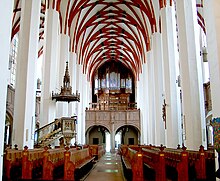
Johann Sebastian Bach composed the church cantata (Bach) Wo soll ich fliehen hin, BWV 5, in Leipzig for the 19th Sunday after Trinity and first performed it on 15 October 1724. It is based on the penitential hymn "Wo soll ich fliehen hin" by Johann Heermann.

Bleib bei uns, denn es will Abend werden, BWV 6, is a cantata by Johann Sebastian Bach for use in a Lutheran service. He composed it in Leipzig in 1725 for Easter Monday and first performed it on 2 April 1725.
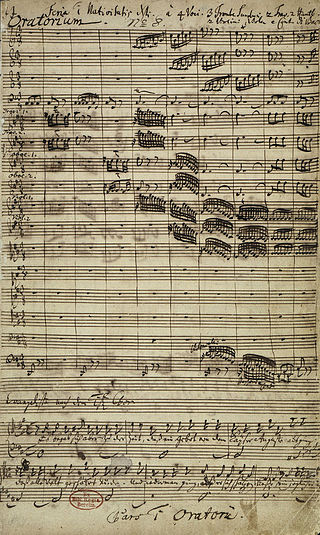
The Christmas Oratorio, BWV 248, is an oratorio by Johann Sebastian Bach intended for performance in church during the Christmas season. It is in six parts, each part a cantata intended for performance in a church service on a feast day of the Christmas period. It was written for the Christmas season of 1734 and incorporates music from earlier compositions, including three secular cantatas written during 1733 and 1734 and a largely lost church cantata, BWV 248a. The date is confirmed in Bach's autograph manuscript. The next complete public performance was not until 17 December 1857 by the Sing-Akademie zu Berlin under Eduard Grell. The Christmas Oratorio is a particularly sophisticated example of parody music. The author of the text is unknown, although a likely collaborator was Christian Friedrich Henrici (Picander).

Jesu, der du meine Seele, BWV 78, is a church cantata by Johann Sebastian Bach. He composed it in Leipzig for the 14th Sunday after Trinity and first performed it on 10 September 1724. It is based on the 1641 hymn by Johann Rist, "Jesu, der du meine Seele", for which it is named. The topic of the chorale, the Passion of Jesus cleansing the believer, is only distantly related to the Sunday's readings.

Johann Sebastian Bach composed the church cantata O Ewigkeit, du Donnerwort, BWV 20, in Leipzig for the first Sunday after Trinity, which fell on 11 June in 1724. Bach composed it when beginning his second year as Thomaskantor in Leipzig. It is the first cantata he composed for his second annual cycle which was planned to contain chorale cantatas, each based on a Lutheran hymn. The cantata is focused on Johann Rist's 1642 hymn "O Ewigkeit, du Donnerwort", with a chorale melody by Johann Schop. The topic of death and eternity matches the Gospel for the Sunday, the parable of the Rich man and Lazarus.
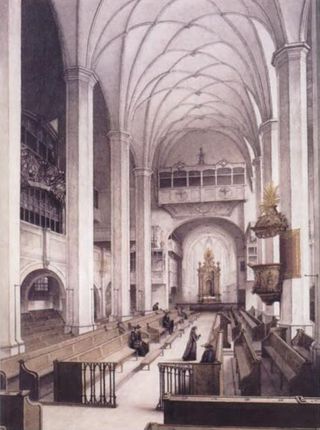
Johann Sebastian Bach composed the church cantata Allein zu dir, Herr Jesu Christ, BWV 33, in Leipzig in 1724 for the thirteenth Sunday after Trinity and first performed it on 3 September 1724. The chorale cantata is based on the 1540 hymn "Allein zu dir, Herr Jesu Christ" by Konrad Hubert.
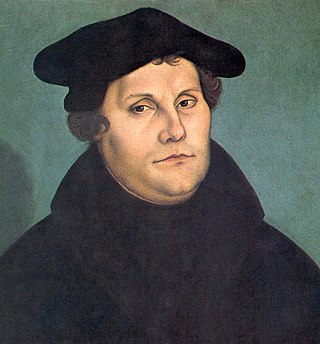
Johann Sebastian Bach composed the church cantata Nun komm, der Heiden Heiland, BWV 62, in Leipzig for the first Sunday in Advent and first performed it on 3 December 1724. It is based on Martin Luther's Advent hymn "Nun komm, der Heiden Heiland", a paraphrase of the Latin hymn "Veni redemptor gentium". The cantata is part of Bach's chorale cantata cycle, the second cycle during his tenure as Thomaskantor that began in 1723. In the format of this cycle, the text of the first and last stanzas of the hymn is retained unchanged while the text of the inner stanzas was paraphrased by an unknown librettist into a sequence of alternating arias and recitatives. The cantata is opened by a chorale fantasia and closed by a four-part chorale setting.

Gott, wie dein Name, so ist auch dein Ruhm, BWV 171, is a church cantata by Johann Sebastian Bach. He composed it in Leipzig for New Year's Day and probably first performed it on 1 January 1729.
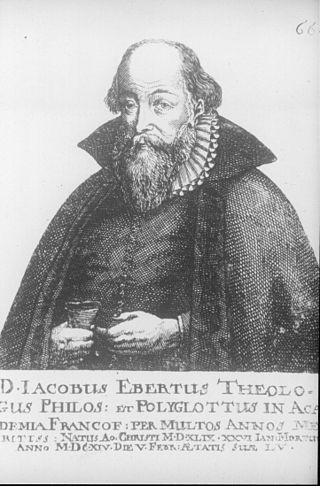
Johann Sebastian Bach composed the church cantata Du Friedefürst, Herr Jesu Christ, BWV 116, in Leipzig for the 25th Sunday after Trinity. He led the first performance on 26 November 1724, concluding the liturgical year of 1724.

Gelobet seist du, Jesu Christ, BWV 91, is a church cantata by Johann Sebastian Bach. He wrote the Christmas cantata in Leipzig in 1724 for Christmas Day and first performed it on 25 December. It is based on the hymn "Gelobet seist du, Jesu Christ" by Martin Luther which was 200 years old when Bach wrote the work.

Singet dem Herrn ein neues Lied, BWV 190, is a church cantata by Johann Sebastian Bach. He wrote it in Leipzig for the New Year's Day and first performed it on 1 January 1724 as part of his first cantata cycle. He adapted it in 1730 to Singet dem Herrn ein neues Lied, BWV 190a, for the celebration of the bicentennial of the Augsburg Confession.

Erhalt uns, Herr, bei deinem Wort, BWV 126, is a cantata by Johann Sebastian Bach for use in a Lutheran service. He composed the chorale cantata in 1725 in Leipzig for the Sunday Sexagesimae, the second Sunday before Lent, and first performed it on 4 February 1725. It is based on the hymn "Erhalt uns, Herr, bei deinem Wort" by Martin Luther, published in 1542. The hymn text at Bach's time also included two stanzas by Justus Jonas and Luther's "Verleih uns Frieden gnädiglich".

Sehet, wir gehn hinauf gen Jerusalem, BWV 159, is a church cantata by Johann Sebastian Bach. He composed it in Leipzig for the Sunday Estomihi, the last Sunday before Lent, and probably first performed it on 27 February 1729. The gospel reading for the Sunday, from the Gospel of Luke, includes Jesus announcing his suffering and death in Jerusalem. The cantata's theme and Bach's music foreshadow his Passion.
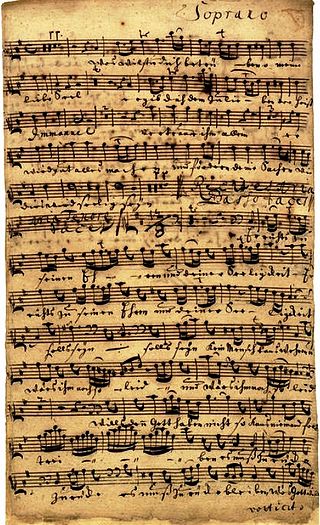
Johann Sebastian Bach composed the church cantata Was willst du dich betrüben, BWV 107 in Leipzig for the seventh Sunday after Trinity and first performed on 23 July 1724. The chorale cantata is based on Johann Heermann's hymn in seven stanzas "Was willst du dich betrüben" (1630).

Johann Sebastian Bach composed the church cantata Nimm von uns, Herr, du treuer Gott, BWV 101, in Leipzig for the tenth Sunday after Trinity and first performed it on 13 August 1724. It is based on the seven stanzas of the hymn of the same name by Martin Moller (1584), which is sung to the tune of "Vater unser im Himmelreich", Luther's metred paraphrase of the Lord's Prayer. The tune is featured prominently in six of the work's seven movements.

Johann Sebastian Bach composed the church cantata Herr Jesu Christ, du höchstes Gut, BWV 113, in Leipzig for the eleventh Sunday after Trinity and first performed it on 20 August 1724. It is based on the eight stanzas of the 1588 hymn "Herr Jesu Christ, du höchstes Gut" by Bartholomäus Ringwaldt, a penitential song.

Johann Sebastian Bach composed the church cantata Schmücke dich, o liebe Seele, BWV 180, in Leipzig for the 20th Sunday after Trinity and first performed it on 22 October 1724.
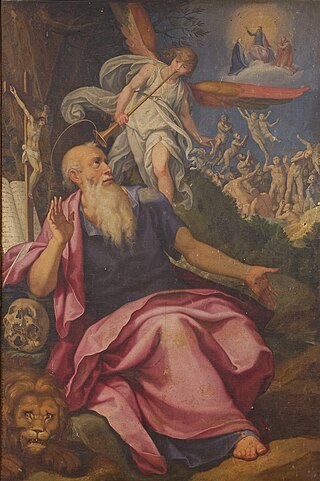
Herr Jesu Christ, wahr' Mensch und Gott, BWV 127, is a cantata by Johann Sebastian Bach for use in a Lutheran service. He composed the chorale cantata in 1725 in Leipzig for the Sunday Estomihi, the Sunday before Lent. It is based on Paul Eber's 1582 hymn in eight stanzas "Herr Jesu Christ, wahr Mensch und Gott". Bach first performed it on 11 February 1725.

Jauchzet, frohlocket! Auf, preiset die Tage, BWV 248I, is a 1734 Christmas cantata by Johann Sebastian Bach that serves as the first part of his Christmas Oratorio. Bach was then Thomaskantor, responsible for church music at four churches in Leipzig, a position he had assumed in 1723. For the oratorio, the libretto by an unknown author followed the nativity of Jesus from the Gospel of Luke, interspersed with reflecting texts for recitatives and arias, and stanzas from Lutheran hymns.

Fallt mit Danken, fallt mit Loben, BWV 248IV, is a Christmas cantata by Johann Sebastian Bach, composed in 1734 as Part IV of his six-part Christmas Oratorio. Each part of the oratorio is a cantata, written for performance on one of the feast days of the Christmas period. Fallt mit Danken, fallt mit Loben is meant for the New Year's Day feast of the circumcision and naming of Jesus. Based on a libretto by an unknown author, it tells the naming of Jesus from the Nativity of Jesus, according to the Gospel of Luke.
